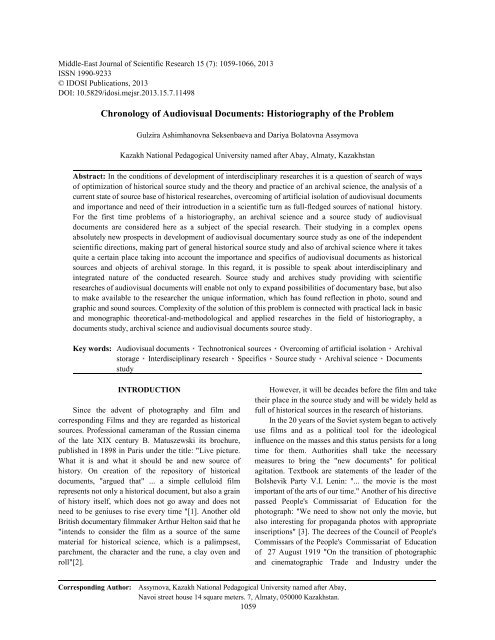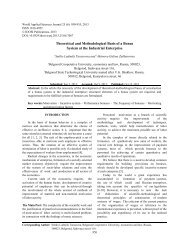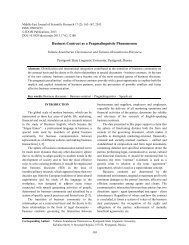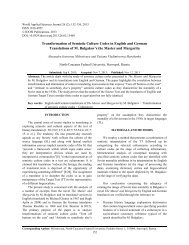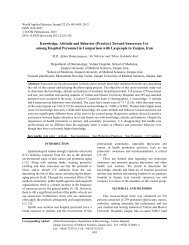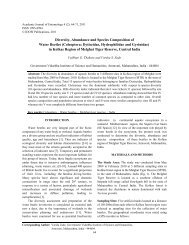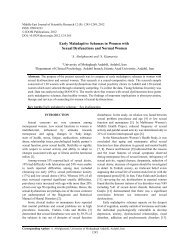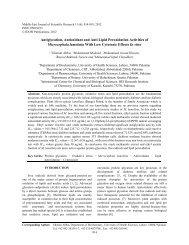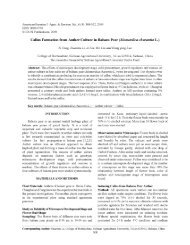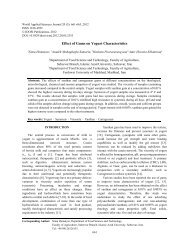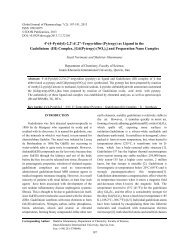Full Text - Idosi.org
Full Text - Idosi.org
Full Text - Idosi.org
Create successful ePaper yourself
Turn your PDF publications into a flip-book with our unique Google optimized e-Paper software.
Middle-East Journal of Scientific Research 15 (7): 1059-1066, 2013<br />
ISSN 1990-9233<br />
© IDOSI Publications, 2013<br />
DOI: 10.5829/idosi.mejsr.2013.15.7.11498<br />
Chronology of Audiovisual Documents: Historiography of the Problem<br />
Gulzira Ashimhanovna Seksenbaeva and Dariya Bolatovna Assymova<br />
Kazakh National Pedagogical University named after Abay, Almaty, Kazakhstan<br />
Abstract: In the conditions of development of interdisciplinary researches it is a question of search of ways<br />
of optimization of historical source study and the theory and practice of an archival science, the analysis of a<br />
current state of source base of historical researches, overcoming of artificial isolation of audiovisual documents<br />
and importance and need of their introduction in a scientific turn as full-fledged sources of national history.<br />
For the first time problems of a historiography, an archival science and a source study of audiovisual<br />
documents are considered here as a subject of the special research. Their studying in a complex opens<br />
absolutely new prospects in development of audiovisual documentary source study as one of the independent<br />
scientific directions, making part of general historical source study and also of archival science where it takes<br />
quite a certain place taking into account the importance and specifics of audiovisual documents as historical<br />
sources and objects of archival storage. In this regard, it is possible to speak about interdisciplinary and<br />
integrated nature of the conducted research. Source study and archives study providing with scientific<br />
researches of audiovisual documents will enable not only to expand possibilities of documentary base, but also<br />
to make available to the researcher the unique information, which has found reflection in photo, sound and<br />
graphic and sound sources. Complexity of the solution of this problem is connected with practical lack in basic<br />
and monographic theoretical-and-methodological and applied researches in the field of historiography, a<br />
documents study, archival science and audiovisual documents source study.<br />
Key words: Audiovisual documents Technotronical sources Overcoming of artificial isolation Archival<br />
storage Interdisciplinary research Specifics Source study Archival science Documents<br />
study<br />
INTRODUCTION<br />
Since the advent of photography and film and<br />
corresponding Films and they are regarded as historical<br />
sources. Professional cameraman of the Russian cinema<br />
of the late XIX century B. Matuszewski its brochure,<br />
published in 1898 in Paris under the title: "Live picture.<br />
What it is and what it should be and new source of<br />
history. On creation of the repository of historical<br />
documents, "argued that" ... a simple celluloid film<br />
represents not only a historical document, but also a grain<br />
of history itself, which does not go away and does not<br />
need to be geniuses to rise every time "[1]. Another old<br />
British documentary filmmaker Arthur Helton said that he<br />
"intends to consider the film as a source of the same<br />
material for historical science, which is a palimpsest,<br />
parchment, the character and the rune, a clay oven and<br />
roll"[2].<br />
However, it will be decades before the film and take<br />
their place in the source study and will be widely held as<br />
full of historical sources in the research of historians.<br />
In the 20 years of the Soviet system began to actively<br />
use films and as a political tool for the ideological<br />
influence on the masses and this status persists for a long<br />
time for them. Authorities shall take the necessary<br />
measures to bring the "new documents" for political<br />
agitation. <strong>Text</strong>book are statements of the leader of the<br />
Bolshevik Party V.I. Lenin: "... the movie is the most<br />
important of the arts of our time." Another of his directive<br />
passed People's Commissariat of Education for the<br />
photograph: "We need to show not only the movie, but<br />
also interesting for propaganda photos with appropriate<br />
inscriptions" [3]. The decrees of the Council of People's<br />
Commissars of the People's Commissariat of Education<br />
of 27 August 1919 "On the transition of photographic<br />
and cinematographic Trade and Industry under the<br />
Corresponding Author:<br />
Assymova, Kazakh National Pedagogical University named after Abay,<br />
Navoi street house 14 square meters. 7, Almaty, 050000 Kazakhstan.<br />
1059
Middle-East J. Sci. Res., 15 (7): 1059-1066, 2013<br />
jurisdiction of the People's Commissariat of Education," historical research, in the context of which addressed the<br />
from February 4, 1926, "On the transfer of the Central issue of the need to source analysis papers man-made, to<br />
Archive of the Russian Federation of negatives of photos identify the reliability and completeness of information<br />
and movies with a historical and revolutionary interest" contained in them, identifying their real capabilities as full<br />
and that the creation of a 1926 Central photo film archive of historical sources.<br />
People's Commissariat of Education, decided not only From this point of view, a manual prepared by M.N.<br />
ideological tasks of the authorities, but also contributed Tikhomirov, was an important step forward, which has<br />
to the better collection and storage of historical sources contributed a photo and video documents and recordings<br />
on film media. In the future, these stores have been into an independent historical sources [6]. Subsequently,<br />
established in all the Union republics. In Kazakhstan, the in studies of source-General, Film and Photo are well<br />
archive of this profile was created in 1943.<br />
positioned among other sources, however, they were only<br />
In the 20-50's a mass of literature on the general a brief characterization in terms of their specificity and<br />
nature of cinema and photography, which was dominated classified under the problem posed by the author [7].<br />
by the ideological orientation of documents on non- In this paper we confine ourselves to the special work<br />
traditional media. During these years, attempts to review directly on the problems of source audiovisual<br />
and photo and video documents as historical sources. documents.<br />
Among these publications should be made of the G.M. Analysis of the literature of 60-80-ies show that the<br />
Boltyansky, who made a great contribution to the study problems of sources of audiovisual documents often turn<br />
and promotion of Film and as objects of historical archival, the mission to preserve the cultural heritage of<br />
research [4]. On the possibility of widespread use in Film the society. Their attention to the problem solution<br />
and scientific, educational purposes and as works of art dictated purely professional objectives, because purely<br />
draw attention to academics B.D. Greeks and M.N. archival theory appraisal of the documents has been<br />
Tihomirov [5].<br />
closely associated with the historical chronology.<br />
However, the tradition of using films and as a means Value judgment in the selection of documents for state<br />
of influencing the consciousness of the masses, which storage requires, above all, their source study analysis.<br />
was implemented by the ideological and cultural As noted, a prominent theorist of archival V.N. Autocratîv<br />
problems of Soviet society, has prevailed for many years. "... archival knowledge was undeveloped and the<br />
In addition, new sources have appeared at the turn of evaluation process was associated directly with the<br />
XIX-XX centuries, did not immediately entered the field of source" [8]. Increased interest in the problems of<br />
historical research. The methodological approach audiovisual archival documents, facilitate discussions<br />
developed by this time, demanded a "historical distance", 60’s among them the nature of the modern theory of<br />
which would make it possible to assess the phenomen’s evaluation of documents in various physical media,<br />
in retrospect.<br />
including two approaches - source materials and<br />
With the beginning of the "thaw" period of our information.<br />
history, increased attention to the problems of source As you know, universal (traditional) method of<br />
specialists. At scientific forums actively discussed criticism source challenges for the study of their origin<br />
problems of historical criticism of the sources of and content, as well as the interpretation of the source as<br />
modern times, the validity of the sources of Soviet-era a whole. Criticism of origin is performed using techniques<br />
methods of scientific criticism and interpretation, external criticism and establishes the authenticity and<br />
developed in relation to the sources of the earlier authorship of the document, the time, place and specific<br />
period. The opportunity to explore the western idea of conditions of its origin and criticism of the content<br />
source. In the source study directs, stick an (internal criticism) provides a logical analysis of the<br />
interdisciplinary approach to the study of the historical source, find out his political orientation, the reliability<br />
nature of the source, its place and importance in historical and completeness of the information contained herein.<br />
knowledge.<br />
The combined use of these conclusions can correctly<br />
Expansion of sources of problems, especially those interpret the source, define the purpose, to pursue the<br />
related to the involvement of a broad base of sources for creator of the document and the meaning is deliberately<br />
the study of social reality, the treatment helped historians invested in it by the author and not deliberately, but<br />
to those born to the technical process - Film and Photo. because of personal orientation of the author, degree of<br />
New documents are gradually becoming an object of awareness, etc.<br />
1060
Middle-East J. Sci. Res., 15 (7): 1059-1066, 2013<br />
In the works of this period of source audiovisual studies the origin, purpose and circumstances of the<br />
documents considered not only in the traditional creation of a source, the researchers focused their<br />
approach of source, but also because of their specificity. attention on the problems of authorship source, its<br />
Turning to the problem of selecting audiovisual dating.<br />
documentation to state custody, the correct solution is According to many researchers, an important role in<br />
largely dependent status of the source base of history, determining the film documents the historical value of film<br />
archivists have paid attention to the signs of Film and editing is knowledge of the law, not only as a technical<br />
Photo Documents of value as historical sources [9]. method of joining parts films together, but above all as a<br />
Some authors have raised issues and place the value cinematic expression of the author's worldview [13].<br />
of these documents among other historical sources, their Note that the major film directors (Eisenstein, Dziga<br />
nature and specificity [10]. Under the scientific direction Vertov, E. Shub, M. Romm, etc.) were determined as a<br />
of the works acquired problems solved traditional source thought installation artist, the idea of seeing the world.<br />
studies.<br />
Stressing the importance of the source of the creators,<br />
Most researchers (A.A. Kuzin, I.S. Fesunenko, I.N. researchers opposed view, offering the study of movie<br />
Kuntikov, M. Roshal) Film and Photo originality in sources dismember it on structural elements (footage,<br />
comparison with other types of historical sources seen in movie phrases, movie periods, movie plots) in order to<br />
the particular embodiment and reflection of the real world. identify the position of the author on various events.<br />
For Film and Photo characterized mainly by "the speed in They rightly believed that the author's attitude to the<br />
the reflection phenomen’s and facts of reality, that is a event in question appears to be fully in separate frames<br />
complete coincidence of the moment of the event and the and in the construction of installation of the film [14].<br />
date of its fixation on the film" [11]. Film and Photo Another aspect of the problem source analysis film<br />
features seen in a tangible medium (print) media.<br />
documents - dating of the source, which plays an<br />
Audiovisual documents, seen as the result of human important role in determining the reliability of the reported<br />
activity, reflecting the events, phenomen’s, the facts in a information. Typically, the release date to the screen the<br />
particular form and as a result, have become objects of finished product is determined by the captions for the<br />
value relationship. Emphasized man-made nature of the film. More difficult to limit the recording date and time of<br />
documents, when the transmission actually uses hardware the film. In such cases, the researchers propose when the<br />
fixation and reproduction of images and sounds. As a date of the study of technical and external features of film<br />
product of technological culture, but their specific means (the size and shape of the perforations, the width of the<br />
to convey the image of a real so expressive that became film, frame size, burst rate, etc.), which varied in a certain<br />
unique in terms of their artistic value and, along with the period of time. A useful source analysis during film<br />
traditional culture (painting, sculpture, architecture, etc.) documents considered circumstantial detail visible in the<br />
becomes a work of art.<br />
shot (posters, billboards, buildings, comparison of<br />
Some authors evaluated the film documents how a different persons, etc.) [15].<br />
more complex kind of documentation, which includes Thus, researchers photo movie sources considered<br />
as separate components: an image (consisting of a series as a single set of documents having a common "genetic"<br />
of <strong>org</strong>anically bound shots - pictures) and records in nature. Among the features of audiovisual sources<br />
(music, narration, etc.). In comparison, photographs indicated: documenting the reality of social life with the<br />
captures a static space cropped form a moment of reality help of technical means, the material medium, common<br />
[12]. purpose and use of these sources, a special social and<br />
Given the general and specific features of audiovisual cultural value of the similarities of storage conditions, etc.<br />
documents, the researchers attributed them to a single Mainstreaming Research in Film and Photo<br />
type of historical sources.<br />
source-angle observed after discussing the problems of<br />
In the area of source of researchers' interests are most the "new archives" in international forums - VII (Moscow,<br />
likely to film documents which, combining more attribute 1972), XI (Paris, 1988) International Congress on<br />
elements, respectively, had considerable information Archives, noted the importance and role of audiovisual<br />
density and potential.<br />
documents in fixing events in modern life and thus<br />
In addition to clarifying these traditionally applied to creating sources for historians. It was emphasized that "...<br />
all kinds of historical sources of research procedures, as the historian can not refuse when they are used by a<br />
the study of the social conditions in which there was known method of a critical approach to the sources" [16].<br />
1061
Middle-East J. Sci. Res., 15 (7): 1059-1066, 2013<br />
Among the problems are often dealt with in sources, archival documents, information periodicals,<br />
monographs, dissertations, scientific publications were memoirs. The problem highlighted in source materials and<br />
the most attractive of the study of cinema and photo archeographic aspects in terms of reliability and real Films<br />
documents the example of their analysis during the and information capabilities to serve as a source base for<br />
October Revolution, World War II [17]. Thus, the guide the study of the chosen topic. The author emphasizes the<br />
E.M. Efgrafova which essentially was the first edition of importance of working with Film and knowledge of the<br />
the school type, by the example of movie photo materials historical situation in which events were recorded on tape,<br />
on "Defense of Moscow" (1941-1942) Focuses on the creating conditions movie photo shoots, the author's<br />
problem of the origin of sources.<br />
relationship to the shooting was proven role movie photo<br />
Special attention to the origin and content of filming agency.<br />
during the October Revolution paid in monographic The significance of film documents how peculiar<br />
studies V.S. Listova [18]. Author on the basis of archival sources are stored for the next generation of unique facts<br />
documents and materials periodicals gives an idea of the of the past and modern history covered in another article<br />
history of the movies "The October Revolution" (1917) in this [22]. It looks at specific film documents how social<br />
and "Anniversary of the Revolution" (1918), with media information from the point of view of their origin,<br />
questions of dating and authenticity of many surveys authenticity. According to the researcher, a prerequisite<br />
taken in the first days of the revolution in Petrograd and Cinedocuments source analysis is to clarify their<br />
Moscow.<br />
authorship, which includes moving pictures along with<br />
The work of another author, V.M. Magidova, who the study and director of design in the process of editing<br />
made a significant contribution to the study of sources of a film, textual analysis of the full range of documentation -<br />
Audiovisual Documents differ by constant attention to operators and directors installation sheets, various types<br />
the problem. His study looks at the problem in a broader of documents clerical origin. Focus of the source analysis<br />
historical perspective. The author refers to the origins of should be made in both its traditional tasks, as disclosure<br />
cinema in Russia and analyzes newsreels Skobelev of origin and content of the source. The author proposes<br />
Committee - charities, who had with him the military and their methods of use of movie sources in historical<br />
cinema, publishing, gramophones and other departments research (individual and aggregate personnel). The latter<br />
whose operators have fixed the royal chronicle of the being preferred as a more informative content on the<br />
events of the First World War, the revolutionary method used.<br />
movements, civil war, etc. newsreel shooting the In the area of source of researchers' interests were<br />
first years of Soviet power are associated with the also problems of studying audio documents as sources of<br />
activity-Moscow Film Committee photo movie division information on the multi-faceted man. Relevant in this<br />
Commissariat of the RSFSR - the first specialized agency respect became refinement of the concept of authorship<br />
of the Soviet film that captures significant events of in relation to audio documents, as the process of its<br />
social, political and cultural life of Russia [19]. The role of creation is complex and multi-step. Analysis of the<br />
the movie covered in this period "as the most available concept discussed with the release of the documentary,<br />
and appropriate way of communist propaganda and journalistic and artistic recordings, as different in a way to<br />
education" [20]. In addition to shifting certain amount of reflect reality. If, in the first case (the documentary<br />
knowledge of the cognitive nature, are analyzed in detail record), the authorship is undeniable that they are the<br />
in the plots of the first Soviet newsreel "Film Week" for person whose voice is on the recording medium, recent<br />
the years 1918-1919 and presents some of the techniques cases the records are creative works with unique<br />
of source criticism film documents (transcript movie script composition, original techniques and expressive means.<br />
- written records extant in the visual frame of the Typically, in such records is editorial, director, sound<br />
documentary film, studying film materials in the frame of engineering process and decoration material, which<br />
the sequence, etc.).<br />
should be subject to a single plan, a single idea. This fact<br />
In another study by the same author attempts to highlights the researchers L.N. Rozanova and L.A.<br />
consider a number of circumstances and facts of the Kobelkova’s [23]. Stressing the nature of the creator<br />
origin of Film and directly related to the period of the background work, they highlight the role of a journalist<br />
October Revolution [21]. It traced the history of the for nonfiction and the sound recordings in works of art.<br />
creation and subsequent evolution involving movie photo This problem is also connected with the author's rights<br />
shoots besides the photo and video documents and other under the law.<br />
1062
Middle-East J. Sci. Res., 15 (7): 1059-1066, 2013<br />
Solving complex issues for the implementation of a document recording through cinema and television<br />
comprehensive critique of source audio-visual technology events and phenomen’s and the facts of<br />
documents, addressed in article V. Magidova "Film and reality in the form of successive images and audio<br />
Photo as a historical source" [24]. This problem is information on the same events, phenomen’s and facts in<br />
considered in the extended version of it in one chapter of the form of speech, music and noise " [26].<br />
his doctoral thesis, which covers the historiography, Researcher noted and unlimited information capacity<br />
source materials and archival archeografic aspects of audio documents, which, unlike the film - and photo<br />
studying Film and Photo [25]. Based on the objectives set source convey information exclusively in audio form.<br />
by the author, the work, in our opinion, should be Taking into account the nature of the least-studied of<br />
considered as a specific result and synthesis of these sources, we select specific features noted author<br />
theoretical and methodological positions and source audio documents.<br />
analysis of techniques, developed in relation to Allocating it to its expressiveness and emotional<br />
audiovisual documents for decades. Reflection of past level tone as a main component audio documents, the<br />
experience of source with film photos documents allows author points to the relationship between media<br />
access to the provisions of the detail.<br />
(mechanical, optical, photographic, magnetic) and<br />
The importance and role of audiovisual documents, informative documents. Audio documents as sources also<br />
the author sees, especially in the multi-functionality of characterized the purpose and features of the assembly<br />
these sources (advocacy, social, cognitive, aesthetic, when preparing audio files, where the obvious role played<br />
technical, etc.) to be performed by them in the field of any by the author's interference in the interpretation of the<br />
modern information society. According to the researcher material [27]. Note that in the study of audiovisual<br />
and their broader role and purpose of sources proves the sources compared with other sources of priority is the<br />
need for a separate field of Film and Photo Research. author aspect.<br />
As for any academic discipline is essential indication The concept of "phonodocuments" formulated by<br />
of its subject matter, focus on his interpretation of the the author as "a document that contains the audio<br />
above authors of sources concerning audiovisual information on the events, phenomen’s and facts of<br />
documents. Formulation of the problem, primarily due to reality, resulting from mechanical, photographic or<br />
the general and specific properties of each of the types of magnetic recording systems" [28].<br />
documents. Through the lens of these features we define Merit consideration as a researcher audiovisual<br />
(definition) movies, photos, audio documents as historical documents contemporary documentation system<br />
documents. Note that the standard definition of these based on their structure, species and semantic properties.<br />
concepts do not exist, since every sphere of society, They outline the rationale for audiovisual documents as<br />
which has to do with Film and Photo, guided by their a "hypersystem" requires the selection within it three<br />
versions of his understanding, in accordance with the completely independent documentary systems: movies,<br />
specific tasks they perform. photos, background documentation and written<br />
The author does not agree with the opinion of some documents directly related to the creation, maintenance<br />
researchers Films and classification as a single type of and technical aspects of the Film and Photo.<br />
historical sources, separates them. They indicated a Another aspect considered by the authors<br />
specificity of documentary photographs as recording concerning the classification of Film and Photo.<br />
alone moments of the subject and thus limit the Introduced a range of classification concepts, including<br />
possibility of knowledge of what is left outside the still as the keynote speaker type Audiovisual Documents<br />
picture. In contrast, the film documents reflect the event (visual resources - photographs, film documents not<br />
is not only visually and metaphorically, as in the voiced; sound sources - audio documents, pictorial and<br />
photographs, but in motion. And with the advent of sound sources - sound and film documents video<br />
sound film, when an <strong>org</strong>anic element of cinematographic soundtrack), a genus of Audiovisual Documents<br />
become track, it becomes not only more difficult to source (documentary, scientific and gaming - Art), type of<br />
(in terms of structure), but also information-intensive. Audiovisual Documents (formal, creative and personal<br />
On this basis and taking into account the specific nature origin). The latter species is the starting sign for their<br />
of film documents as historical sources, the author further classification of species, a clear understanding of<br />
states that "under the" footage "is understood pictorial which is necessary for of source criticism. For this<br />
(silent movie) and AV (audio movie video soundtrack) purpose, the author proposes to group them by genetic<br />
1063
Middle-East J. Sci. Res., 15 (7): 1059-1066, 2013<br />
(in chronological order, the object and the location of the evaluation meaningful value graphic sources [31]. The<br />
recording or writing, authorship, artists, etc.), thematic, author makes the following model: 1) discipline, forming<br />
structural type (genres, etc.) and other purely formal a system of artistic and aesthetic categories of the study<br />
criteria (on mediums size, color, etc.). The author assumes of graphic information. These include art history and<br />
that the specific value of Source study of audiovisual museology and 2) Philosophy (axiology, epistemology,<br />
documents released in the course of their critical analysis aesthetics and hermeneutics), sociology and psychology,<br />
using general and specific (used for Film and Photo) which give information about the structure of the spiritual<br />
techniques and methods of the study of these sources. world as an artist and the viewer and 3) research industry<br />
We draw attention to one of the author's work, (archeology, ethnology, anthropology ), the researchers<br />
published in two issues of professional special edition of report on the peculiarities of origin and in many cases the<br />
"Soviet Archives" - "Film and Photo as an object of evolution of visual sources of disciplines (archival,<br />
sources (historiography of the issue)," because it is archaeography) crowns the process of moving graphic<br />
directly relevant to the issue before us [29]. In an sources to the viewer. Through the use of the theoretical<br />
extensive article summarizes the experience gained in the and methodological bases of these scientific areas defined<br />
study of cinema and photo documents for a long time value of visual information for the formation of social<br />
specialists in different branches of knowledge. Particular historical memory.<br />
focus is on the state of research on various aspects of The author believes that the evaluation of all existing<br />
audiovisual documents in the historical, artistic, film species and varieties of graphic sources can be used for<br />
studies literature, photography, radio and television different approaches. Isolate designated correspondent<br />
journalism. Understanding of experience in Film and Photo these approaches because the problem in question is<br />
source study, in an article in our view, is given a relatively pronounced methodological nature. The most popular in<br />
small place. According to the author, "... a source in this the Western literature (Foucault, H.G. Gadamer, Roland<br />
area is in the making ... Most of the publications on the Barthes and others) is the visual perception of the source<br />
Film and Photo is mostly illustrative and therefore it would text as having an independent system unique in its<br />
be premature to say that they have acquired the same content of linguistic symbols. It involves the<br />
rights on a par with other sources" [30].<br />
implementation of linguistic reconstruction works of<br />
Consequence of major changes of recent decades painting, photography and film documents, for example,<br />
was the elimination monoideology in our society. Against in terms of building exposure and composition of the<br />
the background of changing public attitudes related to work.<br />
restructured humanities and, above all, to its The second approach is based on the interpretation<br />
methodology. In this situation, the theoretical and of visual sources existing as products of the social<br />
methodological problems in the study of audiovisual environment. It uses methods of axiology, which on the<br />
sources of particular importance and relevance. Must be basis of statistical data can determine the range of the<br />
stated that in the Kazakh historical space these problems value to society at a given point in time of spiritual values.<br />
have been the subject of interest of researchers. Third, conventionally called "anthropological and<br />
Widely reported they had found in the pages of phenomenological" (E. Husserl, A.S. Lappo-Danilevsky,<br />
scientific and professional Russian publications, national etc.), considering both historical source as independent<br />
archival source-conferences, "round tables". Discussion beings in general humanitarian space phenomenon of<br />
of researchers found that the most promising are spiritual culture and as evidence of the psychological<br />
Comparative, historical-cultural and anthropological characteristics of its creator.<br />
methods of assessment of cognitive and informational Classical, traditional approach (E. Bernheim, C.<br />
properties of historical sources in general and audiovisual Langlois, R. Senobos) suggests a universal principle of<br />
in particular.<br />
evaluation of all types of sources as carriers of<br />
Problems of source and archive of audiovisual information about historical events. In this approach,<br />
documents specifically discussed at the Fourth shared the stage external and internal criticism available to<br />
All-Russian Conference (April 24-25, 2002, Moscow). the researcher evidence.<br />
Interest is the article G.N. Lanskoy who, while giving From the point of view of an interdisciplinary<br />
priority to the study of graphic sources interdisciplinary assessment of visual sources and the number of objects<br />
approach that considers that certain groups of scientific belonging to the spiritual culture of the society and the<br />
branches form the theoretical and methodological basis of author offers his own, a semiotic approach. According to<br />
1064
Middle-East J. Sci. Res., 15 (7): 1059-1066, 2013<br />
him, only he can adequately assess the significance for fragments or pieces of images and sound, etc. According<br />
use in research practice of art and this proves that the to the author, the purpose of verification of source - the<br />
creator of the graphic source is, above all, a man with the establishment of full compliance with the original and the<br />
necessary technical and creative skills. As for addressing copy.<br />
the reliability of determining the source of the fine, they I would like to draw your attention to an article V.<br />
have resolved in the context of a real relationship to the Magidova, which addresses the most pressing issues<br />
world of the creator of the work and in the logic of public related to the place and role of audiovisual documents in<br />
perception of artistic works [32].<br />
the historical knowledge [35]. These problems are<br />
In the view of researchers in this period is another primarily associated with the underestimation of<br />
problem with methodological character when evaluating historians information potential of audiovisual sources<br />
audiovisual documents as historical sources. We have (entering it in the mental sphere of the historian), lack of<br />
already noted the controversial nature of the definition information on the composition of the historians and the<br />
(definitions) of audiovisual documents. Interest in these content of audiovisual fund of the country, the absence<br />
issues has generated the formation of new documentary of comprehensive information and heuristic of the<br />
systems, the occurrence and distribution of which is archives, the study of source historiographic heritage,<br />
associated with the development of science and active implementation and use of content analysis in the<br />
technology. This has led to the introduction of scientific evaluation of audiovisual sources, etc. It seems that these<br />
use of the term "technotronic documents" in relation to aspects of audiovisual documents acute and before<br />
science and technology, audio-visual, economic and Kazakh historical community. To date, the Kazakh<br />
electronic documents. Because they have a natural historical space potential source study audiovisual<br />
language as a system of signs is not completely sources remains unrealized. The exceptions are a few<br />
decisive role, some researchers had been formulated works of applied nature, which deals with information and<br />
yet another aspect of the treatment of the term educational opportunities for visual and audio sources<br />
"technotronic documents - documents, in whole or in that are stored in the Republican Central State Archive of<br />
part by artificial language technically induced forms Film and Photo Documents and sound recordings [36].<br />
of writing" [33]. The ambiguity of the term "fine source" The possibility and the need to study audiovisual sources<br />
notes the aforementioned author G. Lansky who sees as full of historical sources along with traditional written<br />
the fine specificity of the source, not only in their certificates remain in historical perspective.<br />
ability to communicate information about the phenomena<br />
of social history and the history of the spiritual culture,<br />
REFERENCES<br />
but also that they belong to one of the results of art, of<br />
fiction. 1. Magidov, V.M., 1984. A visible memory of history.<br />
In determining the validity and authenticity of Cit. in the book. pp: 13.<br />
historical sources as a condition for source analysis, some 2. Roshal, L.M., 2002. Beginning of all beginnings. The<br />
authors considered a fairly common as falsification of fact on the screen and cinema thought of "Silver age.<br />
facts and events recorded in audiovisual documents [34]. pp: 37-45.<br />
Thus, VP Goats in his extensive article dwells on the laws 3. Wolves Lannit, L.F., 1980. History is written by the<br />
of creation, existence and exposing fraud historical lens., pp: 44.<br />
sources. They identified the peculiar formula falsification 4. Altshuler, B.A., 1987. Educational cinema:<br />
of historical sources and typology of fraud related to the Development stages: Studies. grants, pp: 12.<br />
phenomenon of counterfeiting. Another researcher, 5. Grekov, B.D., 1939. History and Film. Soviet historical<br />
V.M.Magidov points most often found ways of rigging film. p.p:9-13; 6.Rudelson K.I. 1973. Modern<br />
audiovisual sources, the establishment of which is a Document Classifications, pp: 67.<br />
guarantee of correctness historical conclusions. 7. Chernomorski, M.N., 1966. Chronology History of the<br />
Among them are highlighted: the assembly of the various USSR (Soviet era), pp: 48.<br />
surveys and records, retouching, through which part of 8. Autocratov, V.N., 2001. Theoretical Problems of<br />
the image is replaced by another one, increases or Domestic Archival, pp: 139.<br />
decreases the effect of a necessary element of the iconic 9. Nikiforov, E.I., 1968. On the critical analysis of<br />
shooting, etc., the use of documentaries, TV and radio film material and their place in the State Archives,<br />
dramatizations of real events, the removal of individual pp: 84-95.<br />
1065
Middle-East J. Sci. Res., 15 (7): 1059-1066, 2013<br />
10. Kryukov, L.N., V.F. Runge and V.G. Frolov, 1969. 23. Rozanov, L.N., 1983. On the notion of authorship<br />
Questions source analysis and acquisition of film phonodocuments. Soviet archives, - # 5: 17-21.<br />
documents the state archives. Soviet archives, - # 4. 24. Magidov, V.M., 1992. Film and Photo as a historical<br />
pp: 41-49. source. National History, 5: 104-116.<br />
11. Niculaev, I.S., 1968. On some criteria for the selection 25. He is the same. 1993. Film and Photo: problems of<br />
of movie photo documents. Soviet archives, - # 2: 92. historiography, archival and source. Author. Doc.<br />
12. Magidov, V.M., 1969. Films and source analysis and dis. Moscow, pp: 36.<br />
examination of their value in the historiography of the 26. Magidov, V.M., 1992. Film and Photo as a historical<br />
GDR and Poland. Soviet archives, - # 4: 97. source. National History, # 5: 108.<br />
13. Kryukov, L.N., V.F. Runge and V.G. Frolov, 27. Ibid, pp: 108-109.<br />
1969. Questions source analysis and acquisition 28. Ibid. pp: 109.<br />
of film documents the state archives. Soviet 29. Magidov, V.M., 1991. Film and Photo as an object of<br />
Archives, - # 4: 45.<br />
sources (historiography question). Soviet archives.<br />
14. Gotvalt, V.A., 1909. Cinematograf ("The live photo"), # 4 - P. 27-38; # 5 - p.p: 12-23.<br />
its origin, structure and future public opinion, pp: 20. 30. Ibid. 5 - pp: 18-19.<br />
15. Krakauer, Z., 1974. Nature of the film, pp: 47. 31. Arnkheym, R., 1974. Art and Visual Perception,<br />
16. Kote, V., 1972. Movie photo archival cat, pp: 20. pp: 26-39.<br />
17. Gryunberg, P.N., 2002. History of the beginning of 32. Bedli, H., 1972. Equipment of the Documentary<br />
gramophone recording in Russia. pp: 46. Movie, pp: 44-81.<br />
18. Vaysfeld, I., 1983. Cinema as art form, pp: 68. 33. Gedrovich, F.A., 1998. Technotronic documents -<br />
19. Magidov, V.M., 1984. A visible memory of history. technical result due to the form of written. Bulletin of<br />
M., - pp: 139. the Archivist, 2(44): 73.<br />
20. The most important of all the arts. Lenin on the 34. Magidov, V.M., 1992. Film and Photo as a historical<br />
movie. 1973. Sat documents, pp: 26. source. National History. # 5: 113-114.<br />
21. Magidov, V.M. 1987. Film and State Archival Fund of 35. Magidov, V.M., 2002. Chronology and archival<br />
the USSR during the Great October Socialist audiovisual documents in the historical knowledge.<br />
Revolution. Some problems of source analysis and Archives and a source of national history. Problems<br />
publication (to the question). History of the USSR. of interaction at this stage. Reports at the Fourth<br />
# 5: 129-148. All-Russian Conference, pp: 92-97.<br />
22. He is the same. 1983. Film documents: problems of 36. Ginzburg, S.S., 1974. Sketches of the theory of<br />
source analysis and use in historical studies. History cinema, pp: 70-80.<br />
of the USSR # 1. pp: 92-103.<br />
1066


